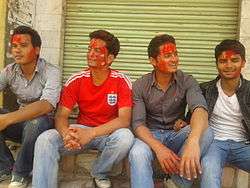Kapilvastu District
Kapilvastu district (Nepali: कपिलवस्तु जिल्ला![]()
Kapilvastu District कपिलवस्तु जिल्ला | |
|---|---|
District | |
 Location of Kapilvastu (dark yellow) in Province 5 | |
| Country | |
| Province | Province No. 5 |
| Government | |
| • Type | Coordination committee |
| • Body | DCC, Kapilvastu |
| Area | |
| • Total | 1,738 km2 (671 sq mi) |
| Population (2011) | |
| • Total | 571,936 |
| • Density | 330/km2 (850/sq mi) |
| Time zone | UTC+05:45 (NPT) |
| Telephone Code | 076 |
| Main Language(s) | Awadhi, Tharu, Urdu, Nepali |
| Website | www |
Geography and climate
The district is situated at a height of 93 to 1,491 metres (305 to 4,892 ft) above sea level.[1] Geographically, the district can be divided into the low land plains of Terai and the low Chure hills.
Kapilvastu is bounded by Rupandehi District to the east, Dang Deukhuri District in Rapti zone to the northwest, Arghakhanchi District to the north, Balrampur district, Awadh region, Uttar Pradesh, India to the west and Siddharthnagar district, Purvanchal region, Uttar Pradesh to the south.
| Climate zone[2] | Elevation range | % of area |
|---|---|---|
| Lower Tropical | below 300 meters (1,000 ft) | 86.8% |
| Upper Tropical | 300 to 1,000 meters 1,000 to 3,300 ft. |
12.0% |
| Subtropical | 1,000 to 2,000 meters 3,300 to 6,600 ft. |
1.2% |
The summer is hot with temperature above 27 °C and winter temperature remains below 15 °C. Due to extremely hot and cold climatic conditions, the people suffer from viral fever, dengue , malaria etc and cold and diarrohea respectively.
Demographics
At the time of the 2011 Nepal census, Kapilvastu District had a population of 571,936. Of these, 49.8% spoke Awadhi, 17.8% Urdu, 17.1% Nepali, 11.3% Tharu, 1.7% Magar and 0.9% Maithili as their first language.[3]
The number of immigrants from the neighboring hilly region is increasing every year.
Administration
The district consists of ten municipalities, out of which six are urban municipalities and four are rural municipalities. These are as follows:[4]
- Kapilvastu Municipality
- Banganga Municipality
- Buddhabhumi Municipality
- Shivaraj Municipality
- Krishnanagar Municipality
- Maharajgunj Municipality
- Mayadevi Rural Municipality
- Yashodhara Rural Municipality
- Suddhodhan Rural Municipality
- Bijaynagar Rural Municipality
Economy
Most of the population of the district is dependent on agriculture. Paddy rice is a major crop of the district. A number of youths rely on foreign employment while sugarcane is an important cash crop.
| Crop | Production in metric tonnes |
|---|---|
| Paddy | > 150,000 |
| Wheat | 25,000-35,000 |
| Sugarcane | > 175,000 |
| Oil seed | 1,000-5,000 |

Population
In 2011 National population and Housing census 2011 was reported that total population of kapilvastu district was 571,936 . Male=285,599 and Female=286,337 and number of total household was 91,321 Data source: central bureau of statistics, kathmandu government of Nepal .
Culture
Awadhi people are the major inhabitants of this region, which is very rich in their culture. Awadhi cuisine is well known. As majority of the population are Muslims, they celebrate Eid(Eid-ul-fitre) and Bakrid( Eid-ul-Adha). Tharu people living in the western part of the district have their own distinct culture. The main culture of Tharu is Maghi. Most of the people in Kapilvastu district are migrated from Arghakhanchi district and few are from the rest of the districts of Lumbini zone. The hindus from the hilly and the permanent local people of the district, specially Brahmin celebrate the festivals like Dashain, Tihar, Janai purnima,Holi etc.
Places of interest
World Marsh Region
A region with biodiversity, cultural, archaeological and historical monuments that has been proposed to be enlisted in the list of World Cultural Heritage of UNESCO.
Archaeological sites
More than 138 historical sites related to Buddha have already been identified within the boundary to the east of Banganga, west of Kothi, north to Indian border and south to Mahendra highway. The forest of the district stands as a natural park. The land is irrigated by the rivers like Banganga, Koili, Surai, Chirai, Bhutera and others.[1] The latest archaeological excavation carried out under the aegis of the Department of Archaeology (DoA) has discovered that Kapilvastu has the highest number of archaeological sites in the country. The department has identified 136 archaeological sites in the district.[5][6][7][8]
See also
- Jagdishpur Lake, Kapilvastu
- Bikuli, Kapilvastu
- Zones of Nepal
- Lumbini Zone
References
- http://www.ddckapilvastu.gov.np/DDCKapilvastu/aboutkapilvastu.htm. Retrieved October 7, 2008. Missing or empty
|title=(help) - The Map of Potential Vegetation of Nepal - a forestry/agroecological/biodiversity classification system (PDF), Forest & Landscape Development and Environment Series 2-2005 and CFC-TIS Document Series No.110., 2005, ISBN 87-7903-210-9, retrieved November 22, 2013
- 2011 Nepal Census, Social Characteristics Tables
- "स्थानिय तह" (in Nepali). Ministry of Federal Affairs and General Administration. Archived from the original on 31 August 2018. Retrieved 1 October 2018.
- "Country's largest number of archaeological sites in Kapilvastu". The Himalayan Times. 2018-02-23. Retrieved 2019-07-04.
- "136 archaeological sites found". The Himalayan Times. 2018-02-24. Retrieved 2019-07-04.
- "136 archaeological spots uncovered in Kapilvastu". My Republica. Retrieved 2019-07-04.
- "Kapilvastu home to 136 archaeological sites – NepalTourNews". Retrieved 2019-07-04.
External links
- "Districts of Nepal". Statoids.

| Wikimedia Commons has media related to Kapilvastu District. |